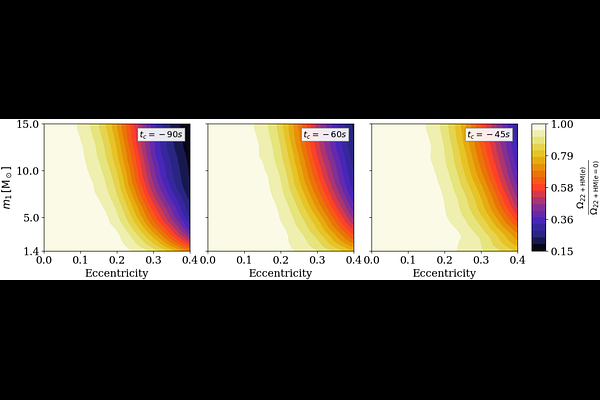Early Warning From Eccentric Compact Binaries: Template Initialization And Sub-dominant Mode Effects

Early Warning From Eccentric Compact Binaries: Template Initialization And Sub-dominant Mode Effects
Priyanka Sinha, R. Prasad, Mukesh Kumar Singh, Prayush Kumar, Akash Maurya, Kaushik Paul
AbstractEarly warning of gravitational waves (GWs) is essential for multi-messenger observations of binary neutron star and black hole-neutron star merger events. In this study, we investigate early warning prospects from eccentric compact binaries, whose mergers are expected to comprise a significant fraction of detected GW events in the future. Eccentric binaries exhibit oscillatory frequency evolution, causing GW frequencies to recur multiple times through their coalescence. Consequently, generating eccentric waveform templates for early warning requires specification of initial conditions. While the standard approach involves initiating waveform generation when the orbit-averaged frequency enters the detector band, we compare this with an alternative approach that uses the periastron frequency as the starting point. Our analysis shows that initializing at the periastron frequency yields an improved signal-to-noise ratio and sky localization. Additionally, including subdominant modes alongside the dominant $(2,2)$ mode leads to further improvements in sky localization. We explore the parameter space of primary mass $m_1 \in [1.4, 15] \, M_\odot$, spin $\chi_1 \in [0, 0.8]$, and eccentricity $e \leq 0.4$ across three detector configurations: O5, Voyager, and 3G. We find that in the O5 (Voyager) configuration, including eccentricity and subdominant modes, the sky localization area can be reduced by $2-80\% (2-85\%)$ at 1000 sq. deg. with increasing eccentricity from $e_5 = 0.1$ to $e_5 = 0.4$, yielding up to $41$ seconds (1 minute) of extra early warning time. For NSBH systems, subdominant modes contribute up to $70$ $(94)\%$ reduction for O5 (Voyager) scenario. In the 3G detector scenario, the sky area reduction due to eccentricity reaches $80\%$ (from $e_{2.5} = 0.1$ to $e_{2.5} = 0.4$) at 100 sq. deg., and subdominant modes enhance the reduction up to $98\%$ for NSBH systems.